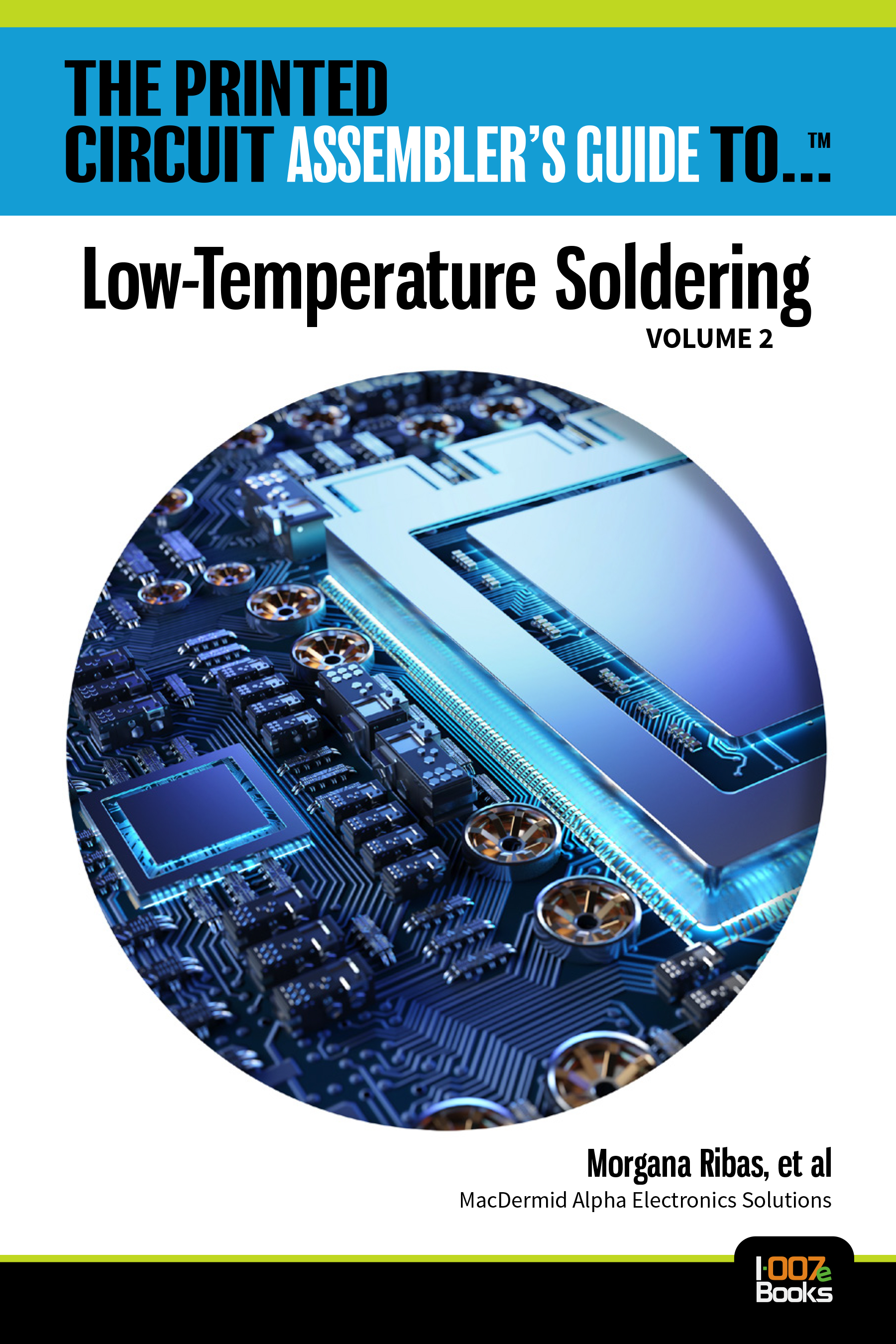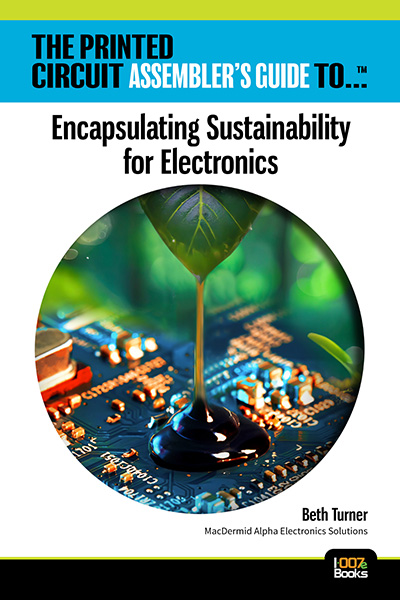-

- News
- Books
Featured Books
- smt007 Magazine
Latest Issues
Current Issue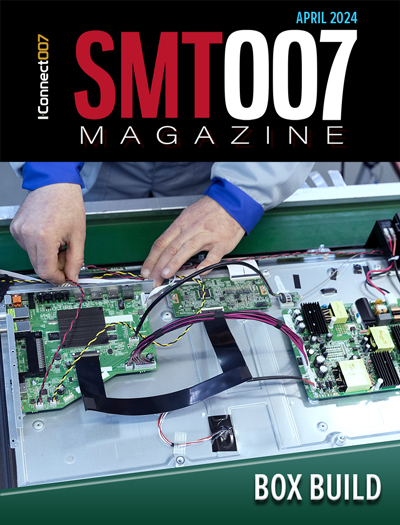
Box Build
One trend is to add box build and final assembly to your product offering. In this issue, we explore the opportunities and risks of adding system assembly to your service portfolio.
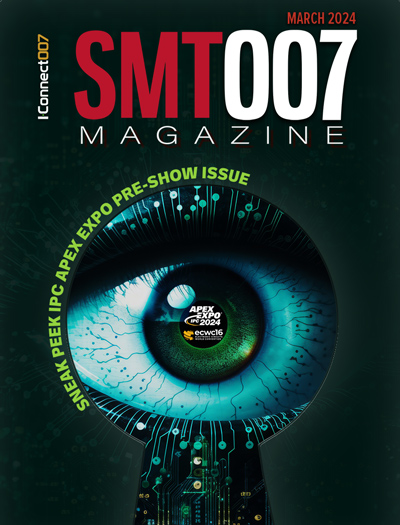
IPC APEX EXPO 2024 Pre-show
This month’s issue devotes its pages to a comprehensive preview of the IPC APEX EXPO 2024 event. Whether your role is technical or business, if you're new-to-the-industry or seasoned veteran, you'll find value throughout this program.
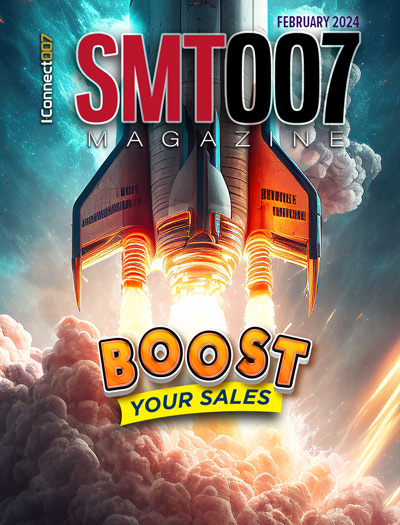
Boost Your Sales
Every part of your business can be evaluated as a process, including your sales funnel. Optimizing your selling process requires a coordinated effort between marketing and sales. In this issue, industry experts in marketing and sales offer their best advice on how to boost your sales efforts.
- Articles
- Columns
Search Console
- Links
- Events
||| MENU - smt007 Magazine
Latest Articles
What to Expect During the First Months of Trading with an EMS Provider
The start of an outsourcing partnership is an exciting time for an OEM, but it's also one that can be daunting. However much you've prepared for that big moment when you hand over responsibility for part or all of your manufacturing operation to your chosen EMS provider, it's still normal to question if you are making the right decision. This article explores five key areas that you and your chosen EMS partner should focus on during the initial months.
Stephen V. Chavez Talks Mil/Aero PCB Design
Stephen V. Chavez, CID+, is the lead PCB designer for the Electronic Systems Center division of UTC Aerospace Systems (UTAS), a military contractor that builds all manner of cutting-edge tools for the American warfigher. He’s been designing military and aerospace PCBs for decades, and he’s a veteran of the United States Marine Corps. I caught up with Steph and asked for his thoughts on designing PCBs for the military and aerospace markets.
QFN Center Pads on PCBs
Not all QFNs come with an exposed metal pad underneath, but most do, and that can still cause problems with reflow solder. The pad itself isn't the problem, but improper solder paste stencil layer design can be.
Process Step Elimination: Driven by Cost and Efficiency, Enabled by Process and Materials Innovation
Electronics manufacturing has evolved from the early days of hand soldering and wave soldering to the more modern SMT process. But while most modern electronics are produced using the SMT process, there are still some mixed technology applications that need both the SMT process and the wave soldering process. This article looks into the pin-in-paste (PiP) process, which enables the soldering of through-hole components during SMT processing, and eliminates the need for the wave process.
IMPACT Interview: Fern Abrams, IPC
At the recent IMPACT Washington D.C. 2017 event, I-Connect007's Patty Goldman speaks with IPC's Fern Abrams to get the inside story on the meeting with EPA.
How Much of My Electronics Manufacturing Should I Outsource?
Once you have decided to outsource to an EMS partner, you need to think about how much of your existing operation you plan to relinquish. This article looks at four distinct areas OEMs outsource—procurement, assembly, test and logistics—explores the benefits associated with relinquishing each of these, and highlights a number of questions that must be considered before any final decision is made.
The Need for Assembly Training and Education
While investing in the latest technologies and having a systems-based approach in your assembly processes are important, the key factors that will make you successful in your continuous improvement goal are the skills, training, and education of your workforce. However you look at it, the human factor remains a critical issue when it comes to your overall efficiency.
X-Ray Inspection of Lead and Lead-Free Solder Joints
As aerospace companies consider the shift to lead-free solder alloys and glues, concerns have been raised about whether their current X-ray inspection and quality-control procedures will still be valid. With lead solder, joints are easily interpreted by the operator or the system imaging software because lead provides excellent image contrasts due to relatively high X-ray absorption compared to that of PCB and component materials. Will this hold true as they shift to lead-free solder compounds?
IPC: Department of Labor Releases RFI to Seek Information on Overtime Regulations
This week, the Department of Labor (DOL) released a Request for Information (RFI) to gather additional feedback from the public on the overtime regulations, which define and delimit exemptions from the Fair Labor Standards Act’s minimum wage and overtime requirements for certain executive, administrative, professional, outside sales and other employees.
Pillarhouse International's Allan Jiang Discusses Selective Soldering Developments
At the recent NEPCON China event in Shanghai, Allan Jiang, sales manager at Pillarhouse International, discusses with I-Connect007 Managing Editor Stephen Las Marias some of the challenges in selective soldering, and technology developments to address these issues.
4 Ways Your EMS Partner Can Respond to Supply Chain Disruption
When disruptions to the electronic component supply chain occur, they are painful. Lead-times can extend overnight, prices can treble, and in some cases, parts are placed on allocation or discontinued altogether. These concerns amplify the need for EMS firms to have practices in place for dealing with supply chain disruption. This article discusses four ways your EMS partner can mitigate risks to your supply chain.
Counterfeit Electronic Components Identification: A Case Study
Counterfeit electronic components are finding their way into today's defense electronics. The problem gets even more complex when procuring diminishing manufacturing source parts. This article provides a brief introduction to counterfeit prevention and detection standards, particularly as they relate to the aerospace and defense sector.
Perspectives from a First-Timer
Brad Heath, president and CEO of EMS company VirTex, is a first-time attendee of IMPACT Washington D.C. In an interview with I-Connect007 Managing Editor Patty Goldman, he talks about his impressions of the recent IMPACT Washington D.C. event, and how he thinks the industry benefits from such meetings with the policy makers in the government.
STI Electronics' Dave Raby Shares His Insights on IMPACT Washington DC 2017
During the recent IMPACT Washington D.C. 2017 event, I-Connect007 Managing Editor Patty Goldman caught up with Dave Raby, president and CEO of EMS firm STI Electronics, to discuss about the event and their meetings with representatives of the government that came over to hear what the collective electronics manufacturing industry has to say.
The Role of Industry Associations in Training and Education
Industry associations, such as the IPC and the SMTA, help advance the electronics manufacturing industry through standardization, training, education, advocacy, and interaction through trade events, exhibitions and symposiums. They help members to become aware of the latest technology developments happening in their industry verticals, and of the market trends shaping the direction of the industry.
Using Lead-Free BGAs in a Tin/Lead Soldering Process
Several electronic market segments, such as those electronics used in harsh environments or that have life/system critical functionality, remain exempt from lead-free material restrictions such as the RoHS legislation. While these market segments can use solder containing lead, it is increasingly difficult to procure advanced components in non-ROHS compliant configurations. This article discusses several aspects of having lead-free BGA components in a tin/lead soldering process.
Thermal Indicator Technology for Aerospace Wire Harness Assemblies
Thermal indicator technology was developed into solder sleeves many years ago and has proven to be an effective means of providing visual indication of a reliable solder joint. This article talks about the two types of thermal indicators used in aerospace applications today, and the many benefits that this type of technology.
Mil/Aero Assembly Success
Davina McDonnell, director of marketing at Michigan-based EMS firm Saline Lectronics, discusses the latest technology and business trends driving the military and aerospace industries, the challenges in these markets—including supply chain issues such as obsolete parts and counterfeit components—and their strategies to stay ahead of the competition.
Field Failure is Not an Option
Audra Gavelis of IEC Electronics Corp. discusses the current challenges in electronics assembly for the military and aerospace markets and the new requirements they are getting from their customers. She also talks about strategies in dealing with component obsolescence and lifecycle issues, and new compliance issues that contract manufacturers are facing.
The Skills Gap – Meet People Where They Are!
A perennial concern in the U.S. electronics manufacturing industry is the lack of skilled talent in many parts of the country. According to a recent IPC member survey, most companies have a hard time recruiting qualified production workers, engineers, and other technical professionals.
Four Ways to Buy Electronic Components and the Pros and Cons of Each
When you buy electronic components, there are a number of different supplier types available to you or your EMS partner. From dealing direct with an electronic manufacturer through to using brokers, there are benefits and pitfalls associated with each.
An Alternative Approach to Vertical Integration in Manufacturing
The days of OEMs owning large vertically integrated manufacturing assets are gone and will probably never return. Oddly, the large vertically integrated manufacturing capability of the OEMs started to be dismantled by the emergence of the EMS companies. Now, some of these same EMS companies are adopting the same, vertically integrated solutions themselves.
The Importance of Training for your Organization
In our recent survey on assembly training and education, another question we asked is about the importance of training to your organization. Around 85% of our respondents consider training really important to their workforce. In fact, the majority of respondents—47%—say it is very important.
New Challenges Facing Mil/Aero Segment
For this month's issue, we invited a sampling of professionals whose experience centers on the electronics industry in the military and aerospace world, including experts from design, PCB manufacturing, and the assembly arena to sit down with us for a frank discussion. Our discussion centered on the challenges associated with military work, including the new regulatory requirements for cybersecurity, dealing with leaded vs. lead-free components, and the differences and similarities with the commercial world.
Using Paste Flux for Rework
When using a hot air or IR rework system where the reflow cycle is mimicking the original SMT reflow profile, and when using flux for re-attachment, paste flux otherwise known as gel or tacky flux is the correct type of flux to use. Due to its high viscosity and tack properties, paste flux prevents components from being moved during hot-air reflow while being able to remain active for the complete time-temperature period.
Does Your EMS Provider Have an Industry 4.0 Roadmap?
At its simplest level, the Fourth Industrial Revolution or Industry 4.0, is about automation and connectivity. This should lead to faster, more efficient manufacturing--and therefore advantageous pricing. Additionally, it might also mean that products can be made in a different way. For example, new processes might allow late customization or configuration, faster delivery, or enhanced quality.
The Importance of Supplier Training
The human factor remains a critical issue when it comes to the overall efficiency of your PCB assembly lines. But how do you make sure your operators, engineers and supervisors have the proper knowledge and skill sets to perform at their peak levels, day in and day out?
Today’s Mil/Aero Enemies: Counterfeits, Obsolescence and Failure
The need for high-reliability electronics, components and assemblies that can perform in harsh operating conditions involving extreme temperatures, vibration, and moisture continue to challenge electronics assembly providers catering to the military and aerospace markets. These are on top of current manufacturing issues such as the miniaturization of products, shrinking component sizes, higher density board assemblies, and the obsolescence of electronic components.
Is Configure to Order Manufacturing the Right Strategy for Me?
This article looks at what the term Configure to Order (CTO) means, the importance of supply chain management, where responsibilities lie when setting up new agreements with an EMS provider, and some of the benefits OEMs can expect to see when adopting a CTO strategy.
The Importance of Conformal Coating, Now and in the Future
At the SMTA Michigan Expo and Tech Forum, held in Grand Rapids on May 11, Technical Editor Happy Holden spent a few minutes with AIM Solder’s Technical Marketing Manager Tim O’Neill to discuss O’Neill’s presentation on the topic of conformal coating over no-clean fluxes.
EMS Firm Tsukiden Electronics Seeing More Business in Prototypes
At the recent Philippine Semiconductor and Electronics Convention and Exhibition (PSECE) held in Manila, Karen Flordiles, marketing supervisor at EMS firm Tsukiden Electronics Philippines Inc., talks about their customers' changing requirements and their manufacturing challenges. She also discussed new opportunities they are seeing in the EMS sector.
Technology Enabler Highlights Benefits of Having Design Services for an EMS Firm
At the 14th Philippine Semiconductor and Electronics Convention and Exhibition (PSECE) held last week in Manila, Robin Ramiso, design and development manager at Technology Enabler, discusses their activities, and the benefits of having a design services team for an EMS company with I-Connect007 Managing Editor Stephen Las Marias.
The Significance of the PCB in the Value Chain of the European EMS Industry
At SMT Nuremberg, Pete Starkey meets with Dieter Weiss, who comments upon the significance of the PCB in the value chain of the European EMS industry, and looks to a future where we embrace an open-minded attitude and a willingness to work together.
A New Player in the Philippine EMS Industry
There's a new EMS player in town. Come August 2017, Artem Global, a startup EMS firm in the Philippines, will start manufacturing operations, with services ranging from PCB assembly to box build, and even turnkey services. I-Connect007 Managing Editor Stephen Las Marias caught up with Artem Managing Director Art Ledonio at last week's PSECE event in Manila.
How Important DFM is for Your Electronics Assembly Partner
Each OEM will have their own set of criteria when it comes to selecting an appropriate EMS provider. But where does design for manufacture (DFM) support come into play? Is it a priority? Should it be? And what benefits does this service have to offer the OEM? This article explores some of the benefits DFM offers OEMs and how this service can help realize elements of an outsourcing strategy.
Better Together: How HDP User Group Showcases the Industry’s Best Side
HDPUG is a non-profit trade organization comprised of members from top companies in the electronics industry, from materials suppliers and manufacturers, to OEMs and end users. Key activities include collaborating on issues facing multiple industries and bringing people together on projects who might not have met otherwise. Barry Matties met HDPUG’s European representative and project facilitator Alun Morgan at the recent EIPC Summer Conference to learn more about the group and current projects.
Assembly Training and Education
Even if your PCB assembly process is optimized, there is always room for improvement. And no matter how successful your company has been in the past, you just can’t rest on your laurels. It is always in your best interest to strive towards a better operations model. We've created a survey to help us gauge the importance of training and education in your workforce, and the benefits that you get in ensuring that your operators and engineers have the most current knowledge and skill sets.
Solder Ball Joint Reliability with Electroless Ni/Pd/Au Plating – Influence of Electroless Pd Plating Film Thickness
This paper investigated the influence of Pd film thickness in electroless Ni/Pd/Au plating on the solder ball joint reliability. It was found out that the shape and thickness of the intermetallic compounds (IMCs) are among the key factors that affect solder joint reliability after multiple reflow cycles and thermal aging, respectively.
Happy Holden Second Recipient of I-Connect007 'Good for the Industry' Award
Our second 'Good for the Industry' award has been presented to Happy Holden. After working with Happy for a number of years it is clear to see that he is dedicated to improving the industry. He has a long history in the PCB industry, starting off with HP in the '70s. Not only did he develop HDI, but he then wrote the HDI Handbook, which is provided to readers at no charge.
High-Volume Test Strategies
In an interview with I-Connect007 during the recent NEPCON China event in Shanghai, Siegmund Hornig, director of global sales for Europe and Asia, for production board test division at Teradyne discusses the new testing demands from customers, and strategies to help them address their high-volume test requirements.
President Donald Trump Launches Workforce Development Week
Earlier this week President Donald Trump announced “Workforce Development Week.” As such, President Trump spent the last four days promoting job creation and even signed executive order expanding apprenticeship programs.
Koh Young Discusses Latest 3D AOI Innovations
Koh Young Technology's Scott Kim, overseas sales team manager, talks about the latest challenges and developments happening in inspection technologies, the new demands and requirements from customers, as well as the key factors to consider when it comes to buying inspection systems.
Global Impact on European PCB Fabrication: EIPC Summer Conference 2017, Day 2
The second day saw the conference room full once more, the late networking session in the bar having resulted in no significant casualties, and I was pleased to accept the invitation to moderate the first session, on processes and materials for flexible PCBs.
How to Make a Bad First Impression with an EMS Provider
Like any relationship, starting off on the wrong foot when finding an EMS provider can quickly trip you up and become painful in the long term. Regardless of the 'why', here are some good examples of what not to do when first approaching a potential EMS provider. This way, you can make sure that you don't end up wasting valuable time and effort finding the wrong EMS provider for your business.
Global Impact on European PCB Fabrication: EIPC Summer Conference 2017, Day 1
Electronics industry professionals from 13 countries, mainly from Europe and Scandinavia, others from the USA, but some from as far away as India and Japan, gathered in Meriden, the centre of England, for the EIPC Summer Conference.
AOI Capabilities Study with 03015 Components
More EMS companies are implementing AOI into their SMT lines to minimize repair costs and maintain good process and product quality, especially for new component types. This project focuses on the testing of 03015 components, which is challenging for AOI.
3D Inspection is the Way to Go
In an interview with SMT Magazine during NEPCON China, Guido Bornemann, head of sales in Asia for Viscom, discusses how inspection technology is keeping up with the latest requirements and demands from customers. He also explains why 3D technology is the best inspection technology to utilize in electronics assembly.
Saki Discusses Industry 4.0 and True 3D Technology
Quintin Armstrong, general manager for North America Sales and Service at Saki America, speaks to SMT Magazine about the Industry 4.0 strategy for inspection equipment providers. He also talks about why manufacturers are finding it more and more relevant to have an inspection line in their assembly lines now.
Why You Should Have Formal Business Reviews with Your EMS Provider
Your working relationship with your EMS provider is fundamentally a partnership. Therefore, it's important to ensure that you carve out time to meet with your EMS provider on a frequent basis – even if you are feeling particularly pleased about having handed over responsibility to them.
3D: Towards Better Inspection Capability
For this month's issue of SMT Magazine, we spoke with Mark McMeen, vice president of engineering at STI Electronics, to know more about the inspection challenges and requirements from an EMS provider's standpoint. We also talked with Jean-Marc Peallat, vice president of global sales at Vi TECHNOLOGY, to find out, from a supplier's perspective, how they are looking at these challenges and addressing them through their product development efforts.
2D X-ray Inspection With Materials and Thickness Identification
The need to inspect electronic components and assemblies non-destructively is the main driver behind the development of X-ray inspection technology. In many cases, X-ray inspection provides the only non-destructive techniques to inspect optically hidden components and solder joints such as BGA, POP, QFN, flip chips, through-holes, TSVs, microbumps, and copper pillars.
HDP User Group 2017 European Meeting Highlights Technology Progress
The conference facility at the offices of Oracle, in the royal burgh of Linlithgow in West Lothian, Scotland, was the venue for the 2017 European meeting of the High Density Packaging User Group. I was delighted and privileged to be invited once again to sit in on the open session, an intense programme of technical presentations and discussions, project reviews, status updates and new project proposals.
The Need for 3D AOI
While the coplanarity of height-sensitive devices such as BGA packages and leaded components can be inspected in 2D using multi-angled colored lighting and side-angle cameras, these will be susceptible to an increase in false calls, a need for additional programming and cycle time, and possible escapes. These factors underscore the need for 3D technology in inspection strategies.
Will You Be RoHS 2-Compliant by 22 July 2017?
The year 2011 saw the legal initiation of the RoHS 2 recast and an update of the RoHS Directive 2011/65/EU, subsequently transpiring into UK law. The initiative granted transition periods of varying time scales to different categories of electrical and electronic equipment products. Now, 2017 sees the end of the transition period for EEE products that fall into one of the subsections of category nine – industrial monitoring and control instruments.
Shenzhen Axxon Discusses Acquisition and Dispensing Market Trends
Ivan Li, general manager at Shenzhen Axxon Automation Co. Ltd (China), discusses their recent acquisition by Mycronic, as well as the latest developments in the dispensing market. Also discussed is the China market, and how the company is staying ahead of the increasing competition in the dispensing industry.
RTW NEPCON CHINA: Teknek Discusses Contact Cleaning Technology Trends
Stephen Mitchell, managing director of Teknek, a contact cleaning solutions provider, discusses the latest trends in contact cleaning technology. He provides his outlook on China’s electronics manufacturing industry and intelligent manufacturing, and talks about how Teknek's contact cleaning systems are helping customers address their defects and productivity issues.
RTW NEPCON CHINA: Interflux to Revolutionize Solder Industry
At the recent NEPCON China event in Shanghai, Daniel Werkhoven, CEO of Belgium-based soldering chemistry provider Interflux Electronics N.V., talks with I-Connect007 Managing Editor Stephen Las Marias about how their new bismuth-based solder alloy will help improve the soldering process.
Tape and Reel Solder Preforms: A Success Story for the UD00 X86 SECO Board
SECO's latest product innovation, UDOO X86, is a real computer with an integrated Arduino 101 compatible board that is capable of running games and videos in 4K. But while the success of the UDOO X86 is impressive, so is SECO's ability to develop this game-changing product with low-cost technology for mass appeal and affordability.
Vapor Degreasing Chemistries to Remove Difficult Lead-Free and No-Clean Fluxes from PCBs
In line with increasing regulations on electronics manufacturing, many changes have been made to the electronics world, and thus the circuit board manufacturing process. Lead-free, no-clean and halide-free flux formulations have introduced new cleaning obstacles, especially on ever-shrinking component sizes. To maintain high cleanliness standards for modern circuitry, new sophisticated cleaning chemistries are required.
The Benefits of Postponement Manufacturing When Outsourcing
With the world changing at an incredible pace, OEMs agile enough to respond rapidly to customer demand stand a greater chance of survival compared to those that are not. This article looks into the late stage configuration technique and some of the benefits an OEM can expect to gain when outsourcing to an EMS provider that offers this service.
- 1
- 2
- 3
- 4
- 5
- 6
- 7
- 8
- 9
- 10
- 11
- 12
- 13
- 14
- 15
- 16
- 17
- 18
- 19
- 20
- 21
- 22
- 23
- 24
- 25
- 26
- 27
- 28
- 29
- 30
- 31
- 32
- 33
- 34
- 35
- 36
- 37
- 38
- 39
- 40
- 41
- 42
- 43
- 44
- 45
- 46
- 47
- 48
- 49
- 50
- 51
- 52
- 53
- 54
- 55
- 56
- 57
- 58
- 59
- 60
- 61
- 62
- 63
- 64
- 65
- 66
- 67
- 68
- 69
- 70
- 71
- 72
- 73
- 74
- 75
- 76
- 77
- 78
- 79
- 80
- 81
- 82
- 83
- 84
- 85
- 86
- 87
- 88
- 89
- 90
- 91
- 92
- 93
- 94
- 95
- 96
- 97
- 98
- 99
- 100
- 101
- 102
- 103
- 104
- 105
- 106
- 107
- 108
- 109
- 110
- 111
- 112
- 113
- 114
- 115
- 116
- 117
- 118
- 119
- 120
- 121
- 122
- 123
- 124
- 125
- 126
- 127
- 128
- 129
- 130
- 131
- 132
- 133
- 134
- 135
- 136
- 137
- 138
- 139
- 140
- 141
- 142
- 143
- 144
- 145
- 146
- 147
- 148
- 149
- 150
- 151
- 152
- 153
- 154
- 155
- 156
- 157
- 158
- 159
- 160
- 161
- 162
- 163
- 164
- 165
- 166
- 167
- 168
- 169
- 170
- 171
- 172
- 173
- 174
- 175
- 176
- 177
- 178
- 179
- 180
- 181
- 182
- 183
- 184
- 185
- 186
- 187
- 188
- 189
- 190
- 191
- 192
Copyright © 2024 I-Connect007 | IPC Publishing Group Inc. All rights reserved.
Log in
